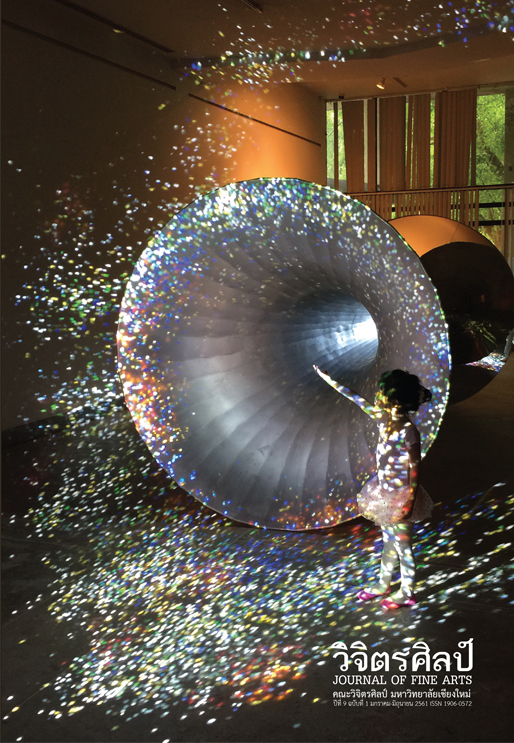จิต – จักรวาล: การสร้างสรรค์ศิลปะร่วมสมัยให้เป็นสื่อสร้างสำนึกทางศีลธรรม
Main Article Content
Abstract
Spirit - Univeres
The purposes of this research were to investigate and synthesize the history of the origin as well as the meaning of the representation of the Tribhumi and Buddhist cosmological beliefs along with the concepts, symbols and patterns of art in conventional and contemporary Thai paintings as morality reminiscence in order to provide inspiration and guidelines for the creation of contemporary arts for morality reminiscence media. The research revealed that the Tribhumi and Buddhist cosmological beliefs formed the body of knowledge or understanding that explained the characteristics and spiritual structure through creating the imagination reflecting the natural forms and images of abstract concepts through symbols that went well with some concrete experiences of the corporeal world. According to Buddhism, the Tribhumi referred to the mundane world of all beings in the samsara or cycle of birth and death depending on their karma, good and bad deeds or actions, comprising the carnal world of desire, the corporeal world and the formless world. The concept of Tribhumi could be said to form the an important basis of Thai society and culture, reflecting the values and significance of Buddhism and the monarch which appeared in both paintings and stories of the people in the ancient times about the worlds and physical structure of the earth and the universe in various forms and creative techniques as a kind of symbolic relationship with other kinds of Buddhist art in a holistic way. Furthermore, the researcher created some pieces of contemporary art based on the interpretation of the beliefs related to the Tribhumi and Buddhist cosmology such as the Buddhist concepts of mundane-supermundane, cycle of birth and death, the lotus, six rays emanating from the head of the Lord Buddha, the flag or tung sacrifice offering, art of glass decoration, the plan of Lanna ubosot and wiharn structure of Buddhist temples, including 3 sets of contemporary installations and mixed media as a means of creating moral and ethical conscience among the general public.
Article Details
References
2. คึกฤทธิ์ ปราโมทย์ และคณะ. ลักษณะไทย ภูมิหลัง. พิมพ์ครั้งที่ 3. กรุงเทพฯ:
ไทยวัฒนาพานิช, 2551.
3. จารวี มั่นสินธร. “การศึกษาวิเคราะห์เรื่อง “ดอกบัว” ในคัมภีร์พระพุทธศาสนา
เถรวาท.” ปริญญานิพนธ์พุทธศาสตรมหาบัณฑิต มหาวิทยาลัยมหา
จุฬาลงกรณราชวิทยาลัย, 2547.
4. โชติ กัลยาณมิตร. พจนานุกรมสถาปัตยกรรม และศิลปะที่เกี่ยวเนื่อง. พิมพ์
ครั้งที่ 2. กรุงเทพฯ: ด่านสุทธาการพิมพ์, 2548.
5. พระไตรปิฎกภาษาไทย ฉบับมหาจุฬาลงกรณราชวิทยาลัย. กรุงเทพฯ: มหา
จุฬาลงกรณราชวิทยาลัย, 2539.
6. พระไตรปิฎกภาษาไทย ฉบับหลวง. กรุงเทพฯ: กรมการศาสนา กระทรวง
ศึกษาธิการ, 2525.
7. พระธรรมปิฎก. (ป.อ. ปยุตโต). ไตรภูมิพระร่วงอิทธิพลต่อสังคมไทย. กรุงเทพฯ:
โกมลคีมทอง, 2542.
8. ________. พจนานุกรมพุทธศาสตร์ ฉบับประมวลศัพท์. พิมพ์ครั้งที่ 9.
กรุงเทพฯ: มหาจุฬาลงกรณราชวิทยาลัย, 2543.
9. ฟื้น ดอกบัว. พุทธปรัชญาแห่งชีวิต. กรุงเทพฯ: สำนักพิมพ์ศยาม, 2550.
10. มณี พยอมยงค์. เครื่องสักการะล้านนาไทย. เชียงใหม่: ส.ทรัพย์การพิมพ์,
2549.
11. ระวี ภาวิไล. โลกทัศน์ ชีวทัศน์: เปรียบเทียบวิทยาศาสตร์กับพระพุทธศาสนา.
กรุงเทพฯ: สหธรรมิก, 2543.
12. ราชบัณฑิตยสถาน. พจนานุกรมศัพท์ศิลปกรรม อักษร ก-ฮ ฉบับ
ราชบัณฑิตยสถาน. กรุงเทพฯ: ด่านสุทธาการพิมพ์ จำกัด, 2550.
13. ฤดีรัตน์ กายราศ. บัว: องค์ประกอบประวัติศาสตร์ ศิลปวัฒนธรรมไทย.
กรุงเทพฯ: กรมศิลปากร, 2540.


